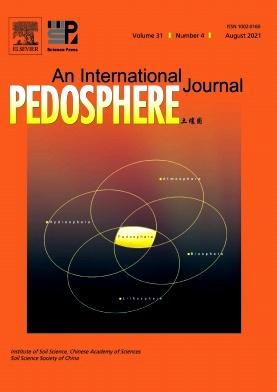湿地植物-微生物共生体对重金属的强化去除:环境重金属调控的潜在策略和机制展望
IF 5.2
2区 农林科学
Q1 SOIL SCIENCE
引用次数: 0
摘要
湿地植物及其相关的环境界面被广泛的微生物群落定植,植物与微生物的共生系统可以相互作用和合作,在金属污染的环境修复中发挥着重要作用,引起了人们的广泛关注。湿地植物优势群落在污染条件下仍具有较高的处理性能和成活率。许多研究表明,由于根际微生物的相互作用,超富集金属植物积累重金属的能力比无菌土壤中的植物高出数倍。因此,人们正在探索利用生物技术改造植物来修复重金属,并提高湿地植物、内生菌和根际微生物对不利环境的适应能力。新型植物修复技术和高效内生菌接种增强型共生技术正在被研究和应用于湿地系统重金属植物修复中。因此,本文对湿地系统的界面特征和共生生物的相互作用进行了系统的综述,重点介绍了湿地系统中植物-微生物共生对重金属的去除潜力和调控机制,以及植物-微生物群落在湿地重金属修复中的应用。此外,我们还探讨了内源-生态微生物联合修复湿地系统的机制。在最近的研究中,外源细菌极大地重塑了根际微生物群,进一步提高了根际功能酶的活性,根际区域的金属去除率高达95%。为了提高植物-微生物组工程在湿地环境污染治理中的有效性,探讨了采用协同技术和考虑多种环境因素的重要性。本文章由计算机程序翻译,如有差异,请以英文原文为准。
Enhanced removal of heavy metals by wetland plant-microbiome symbiont: Prospect of potential strategies and mechanisms for environmental heavy metal regulation
Wetland plants and their related environmental interfaces are colonized by a wide range of microbial communities, and the symbiotic system of plants and microorganisms can interact and cooperate with each other, playing an important role in environmental remediation of metal pollution, which has garnered significant attention. The dominant communities of wetland plants still have high treatment performance and survival rate under pollution conditions. Many studies show that hyperaccumulating metallophytes have the capacity to accumulate heavy metal up to several times higher than the plants in sterile soil, due to the interaction of microbes within the rhizosphere. Thus, biotechnological efforts are being explored to modify plants for heavy metal phytoremediation and to improve the adaptation of wetland plants, endophytes, and rhizospheric microorganisms to adverse environment. New phytoremediation techniques and enhanced symbiosis technique for endophytic bacteria inoculation with high efficiency are being pursued and utilized in heavy metal phytoremediation in wetland systems. Therefore, in this review, we systematically summarized the interface characteristics of wetland systems and the interaction of symbionts, with emphasis on the enhanced removal potential and regulation mechanisms of heavy metals by plant-microbe symbiosis in wetland systems, along with the applications of plant-microbiomes for heavy metal remediation in wetlands. Moreover, we explored the remediation mechanisms of combined endogenic-ecophytic microorganisms for wetland systems. In recent research, the exogeneous bacteria drastically remodeled the rhizospheric microbiome and further improved the activity of rhizospheric functional enzymes, with the metal removal at the rhizospheric region reaching up to 95%. In order to increase the effectiveness of plant-microbiome engineering in addressing wetland environmental pollution, the significance of incorporating synergistic techniques and taking a variety of environmental factors was discussed.
求助全文
通过发布文献求助,成功后即可免费获取论文全文。
去求助
来源期刊

Pedosphere
环境科学-土壤科学
CiteScore
11.70
自引率
1.80%
发文量
147
审稿时长
5.0 months
期刊介绍:
PEDOSPHERE—a peer-reviewed international journal published bimonthly in English—welcomes submissions from scientists around the world under a broad scope of topics relevant to timely, high quality original research findings, especially up-to-date achievements and advances in the entire field of soil science studies dealing with environmental science, ecology, agriculture, bioscience, geoscience, forestry, etc. It publishes mainly original research articles as well as some reviews, mini reviews, short communications and special issues.
 求助内容:
求助内容: 应助结果提醒方式:
应助结果提醒方式:


